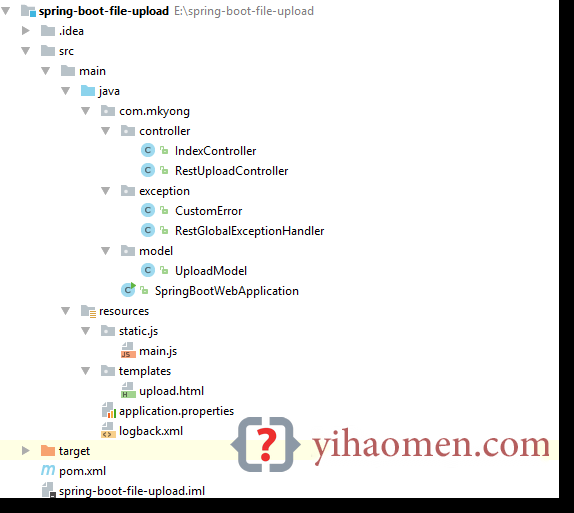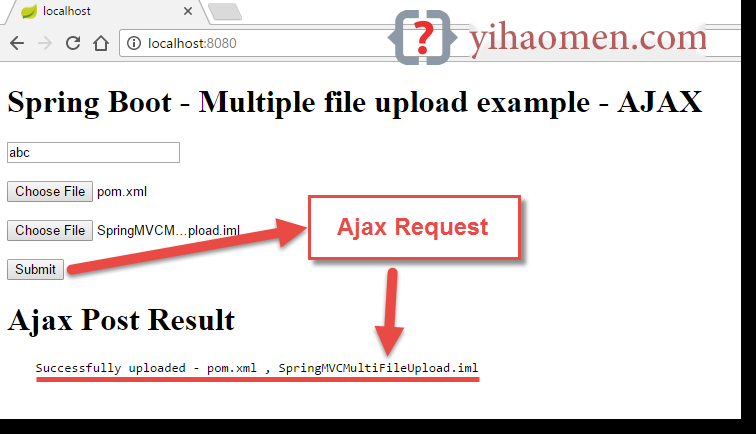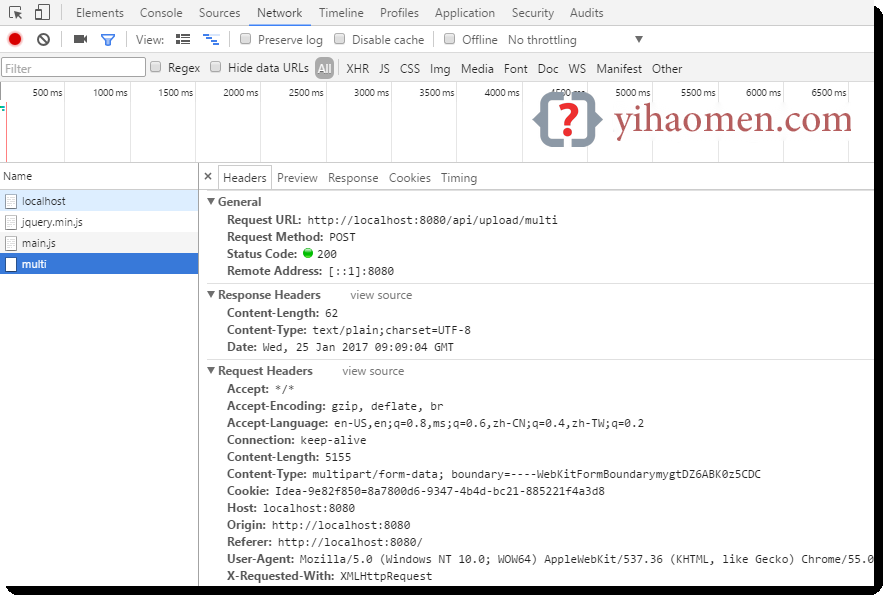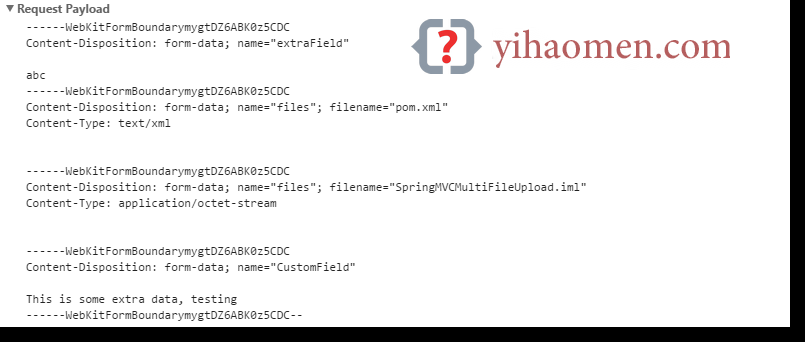Spring Boot file upload example Ajax and REST
This article shows you how to upload files in Spring Boot web application (REST structure), using Ajax requests.
Tools used in this article :
- Spring Boot 1.4.3.RELEASE
- Spring 4.3.5.RELEASE
- Thymeleaf
- jQuery (webjars)
- Maven
- Embedded Tomcat 8.5.6
- Google Chrome Browser (Network Inspect)
1. Project Structure
A standard Maven project structure.

2. Project Dependency
Declares an extra jQuery webjar dependency, for Ajax requests in HTML form.
<project xmlns="http://maven.apache.org/POM/4.0.0"
xmlns:xsi="http://www.w3.org/2001/XMLSchema-instance"
xsi:schemaLocation="http://maven.apache.org/POM/4.0.0
http://maven.apache.org/maven-v4_0_0.xsd">
<modelVersion>4.0.0</modelVersion>
<groupId>com.mkyong</groupId>
<artifactId>spring-boot-file-upload</artifactId>
<packaging>jar</packaging>
<version>1.0</version>
<parent>
<groupId>org.springframework.boot</groupId>
<artifactId>spring-boot-starter-parent</artifactId>
<version>1.4.3.RELEASE</version>
</parent>
<properties>
<java.version>1.8</java.version>
</properties>
<dependencies>
<dependency>
<groupId>org.springframework.boot</groupId>
<artifactId>spring-boot-starter-thymeleaf</artifactId>
</dependency>
<!-- hot swapping, disable cache for template, enable live reload -->
<dependency>
<groupId>org.springframework.boot</groupId>
<artifactId>spring-boot-devtools</artifactId>
<optional>true</optional>
</dependency>
<dependency>
<groupId>org.webjars</groupId>
<artifactId>jquery</artifactId>
<version>2.2.4</version>
</dependency>
</dependencies>
<build>
<plugins>
<!-- Package as an executable jar/war -->
<plugin>
<groupId>org.springframework.boot</groupId>
<artifactId>spring-boot-maven-plugin</artifactId>
</plugin>
</plugins>
</build>
</project>
3. File Upload
To support Ajax request and response, the easiest solution is returned a ResponseEntity.
3.1 The below example demonstrates three possible ways to upload files:
- Single file upload – MultipartFile
- Multiple file upload – MultipartFile[]
- Map file upload to a Model – @ModelAttribute
package com.mkyong.controller;
import com.mkyong.model.UploadModel;
import org.slf4j.Logger;
import org.slf4j.LoggerFactory;
import org.springframework.http.HttpHeaders;
import org.springframework.http.HttpStatus;
import org.springframework.http.ResponseEntity;
import org.springframework.util.StringUtils;
import org.springframework.web.bind.annotation.ModelAttribute;
import org.springframework.web.bind.annotation.PostMapping;
import org.springframework.web.bind.annotation.RequestParam;
import org.springframework.web.bind.annotation.RestController;
import org.springframework.web.multipart.MultipartFile;
import java.io.IOException;
import java.nio.file.Files;
import java.nio.file.Path;
import java.nio.file.Paths;
import java.util.Arrays;
import java.util.List;
import java.util.stream.Collectors;
@RestController
public class RestUploadController {
private final Logger logger = LoggerFactory.getLogger(RestUploadController.class);
//Save the uploaded file to this folder
private static String UPLOADED_FOLDER = "F://temp//";
// 3.1.1 Single file upload
@PostMapping("/api/upload")
// If not @RestController, uncomment this
//@ResponseBody
public ResponseEntity<?> uploadFile(
@RequestParam("file") MultipartFile uploadfile) {
logger.debug("Single file upload!");
if (uploadfile.isEmpty()) {
return new ResponseEntity("please select a file!", HttpStatus.OK);
try {
saveUploadedFiles(Arrays.asList(uploadfile));
} catch (IOException e) {
return new ResponseEntity<>(HttpStatus.BAD_REQUEST);
return new ResponseEntity("Successfully uploaded - " +
uploadfile.getOriginalFilename(), new HttpHeaders(), HttpStatus.OK);
// 3.1.2 Multiple file upload
@PostMapping("/api/upload/multi")
public ResponseEntity<?> uploadFileMulti(
@RequestParam("extraField") String extraField,
@RequestParam("files") MultipartFile[] uploadfiles) {
logger.debug("Multiple file upload!");
// Get file name
String uploadedFileName = Arrays.stream(uploadfiles).map(x -> x.getOriginalFilename())
.filter(x -> !StringUtils.isEmpty(x)).collect(Collectors.joining(" , "));
if (StringUtils.isEmpty(uploadedFileName)) {
return new ResponseEntity("please select a file!", HttpStatus.OK);
try {
saveUploadedFiles(Arrays.asList(uploadfiles));
} catch (IOException e) {
return new ResponseEntity<>(HttpStatus.BAD_REQUEST);
return new ResponseEntity("Successfully uploaded - "
+ uploadedFileName, HttpStatus.OK);
// 3.1.3 maps html form to a Model
@PostMapping("/api/upload/multi/model")
public ResponseEntity<?> multiUploadFileModel(@ModelAttribute UploadModel model) {
logger.debug("Multiple file upload! With UploadModel");
try {
saveUploadedFiles(Arrays.asList(model.getFiles()));
} catch (IOException e) {
return new ResponseEntity<>(HttpStatus.BAD_REQUEST);
return new ResponseEntity("Successfully uploaded!", HttpStatus.OK);
//save file
private void saveUploadedFiles(List<MultipartFile> files) throws IOException {
for (MultipartFile file : files) {
if (file.isEmpty()) {
continue; //next pls
byte[] bytes = file.getBytes();
Path path = Paths.get(UPLOADED_FOLDER + file.getOriginalFilename());
Files.write(path, bytes);
3.2 A simple model for above example 3.1.3 – @ModelAttribute
package com.mkyong.model;
import org.springframework.web.multipart.MultipartFile;
public class UploadModel {
private String extraField;
private MultipartFile[] files;
//getters and setters
4. The Views
HTML form for multiple file uploads.
<!DOCTYPE html>
<html xmlns:th="http://www.thymeleaf.org">
<body>
<h1>Spring Boot - Multiple file upload example - AJAX</h1>
<form method="POST" enctype="multipart/form-data" id="fileUploadForm">
<input type="text" name="extraField"/><br/><br/>
<input type="file" name="files"/><br/><br/>
<input type="file" name="files"/><br/><br/>
<input type="submit" value="Submit" id="btnSubmit"/>
</form>
<h1>Ajax Post Result</h1>
<pre>
<span id="result"></span>
</pre>
<script type="text/javascript"
src="webjars/jquery/2.2.4/jquery.min.js"></script>
<script type="text/javascript" src="js/main.js"></script>
</body>
</html>
5. jQuery – Ajax Request
jQuery to get the form via form #id, and send the multipart form data via Ajax request.
$(document).ready(function () {
$("#btnSubmit").click(function (event) {
//stop submit the form, we will post it manually.
event.preventDefault();
fire_ajax_submit();
});
});
function fire_ajax_submit() {
// Get form
var form = $('#fileUploadForm')[0];
var data = new FormData(form);
data.append("CustomField", "This is some extra data, testing");
$("#btnSubmit").prop("disabled", true);
$.ajax({
type: "POST",
enctype: 'multipart/form-data',
url: "/api/upload/multi",
data: data,
//http://api.jquery.com/jQuery.ajax/
//https://developer.mozilla.org/en-US/docs/Web/API/FormData/Using_FormData_Objects
processData: false, //prevent jQuery from automatically transforming the data into a query string
contentType: false,
cache: false,
timeout: 600000,
success: function (data) {
$("#result").text(data);
console.log("SUCCESS : ", data);
$("#btnSubmit").prop("disabled", false);
},
error: function (e) {
$("#result").text(e.responseText);
console.log("ERROR : ", e);
$("#btnSubmit").prop("disabled", false);
});
6. Exception Handler
To handle exception from Ajax request, just extends ResponseEntityExceptionHandler and return back a ResponseEntity.
package com.mkyong.exception;
import org.springframework.http.HttpStatus;
import org.springframework.http.ResponseEntity;
import org.springframework.web.bind.annotation.ControllerAdvice;
import org.springframework.web.bind.annotation.ExceptionHandler;
import org.springframework.web.bind.annotation.ResponseBody;
import org.springframework.web.multipart.MultipartException;
import org.springframework.web.servlet.mvc.method.annotation.ResponseEntityExceptionHandler;
import javax.servlet.http.HttpServletRequest;
//http://docs.spring.io/spring-boot/docs/current/reference/htmlsingle/#boot-features-error-handling
@ControllerAdvice
public class RestGlobalExceptionHandler extends ResponseEntityExceptionHandler {
// Catch file size exceeded exception!
@ExceptionHandler(MultipartException.class)
@ResponseBody
ResponseEntity<?> handleControllerException(HttpServletRequest request, Throwable ex) {
HttpStatus status = getStatus(request);
return new ResponseEntity(ex.getMessage(), status);
// example
//return new ResponseEntity("success", responseHeaders, HttpStatus.OK);
private HttpStatus getStatus(HttpServletRequest request) {
Integer statusCode = (Integer) request.getAttribute("javax.servlet.error.status_code");
if (statusCode == null) {
return HttpStatus.INTERNAL_SERVER_ERROR;
return HttpStatus.valueOf(statusCode);
7. DEMO
Start Spring Boot with the default embedded Tomcat mvn spring-boot:run.
7.1 Access http://localhost:8080/, select few files and clicks submit to fire the ajax request.

7.2 Google Chrome, review the request and response in the “Network Inspect”

7.3 Google Chrome, “Request Payload”

8. cURL Testing
More testing with cURL command.
8.1 Test single file upload.
$ curl -F file=@"f:\\data.txt" http://localhost:8080/api/upload/ Successfully uploaded - data.txt
8.2 Test multiple file upload.
$ curl -F extraField="abc" -F files=@"f://data.txt" -F files=@"f://data2.txt" http://localhost:8080/api/upload/multi/ Successfully uploaded - data.txt , data2.txt
8.3 Test multiple file upload, maps to Model.
$ curl -F extraField="abc" -F files=@"f://data.txt" -F files=@"f://data2.txt" http://localhost:8080/api/upload/multi/model Successfully uploaded!
8.4 Test a large movie file (100MB), the following error message will be displayed.
$ curl -F file=@"F://movies//300//Sample.mkv" http://localhost:8080/api/upload/ Attachment size exceeds the allowable limit! (10MB)
9. cURL Testing + Custom Error object
9.1 Create an object to store the error detail.
package com.mkyong.exception;
public class CustomError {
String errCode;
String errDesc;
public CustomError(String errCode, String errDesc) {
this.errCode = errCode;
this.errDesc = errDesc;
//getters and setters
9.2 Update the global exception handler to support CustomError object.
package com.mkyong.exception;
import org.springframework.http.HttpStatus;
import org.springframework.http.ResponseEntity;
import org.springframework.web.bind.annotation.ControllerAdvice;
import org.springframework.web.bind.annotation.ExceptionHandler;
import org.springframework.web.bind.annotation.ResponseBody;
import org.springframework.web.multipart.MultipartException;
import org.springframework.web.servlet.mvc.method.annotation.ResponseEntityExceptionHandler;
import javax.servlet.http.HttpServletRequest;
@ControllerAdvice
public class RestGlobalExceptionHandler extends ResponseEntityExceptionHandler {
@ExceptionHandler(MultipartException.class)
@ResponseBody
ResponseEntity<?> handleControllerException(HttpServletRequest request, Throwable ex) {
HttpStatus status = getStatus(request);
return new ResponseEntity(new CustomError("0x000123",
"Attachment size exceeds the allowable limit! (10MB)"), status);
//return new ResponseEntity("Attachment size exceeds the allowable limit! (10MB)", status);
private HttpStatus getStatus(HttpServletRequest request) {
Integer statusCode = (Integer) request.getAttribute("javax.servlet.error.status_code");
if (statusCode == null) {
return HttpStatus.INTERNAL_SERVER_ERROR;
return HttpStatus.valueOf(statusCode);
9.3 cURL to upload a large file again.
$ curl -F file=@"F://movies//300//Sample.mkv" http://localhost:8080/api/upload/
{"errCode":"0x000123","errDesc":"Attachment size exceeds the allowable limit! (10MB)"}
Done. Feedback is welcome.
10. Download Source Code
References
- Spring Boot – Error Handling
- Spring Boot file upload example
- Spring MVC file upload example
- Spring Boot Hello World Example – Thymeleaf
- Wikipedia – cURL
- jQuery.ajax()
- MDN – Using FormData Objects
From:一号门
Previous:cURL Post JSON data to Spring REST

COMMENTS